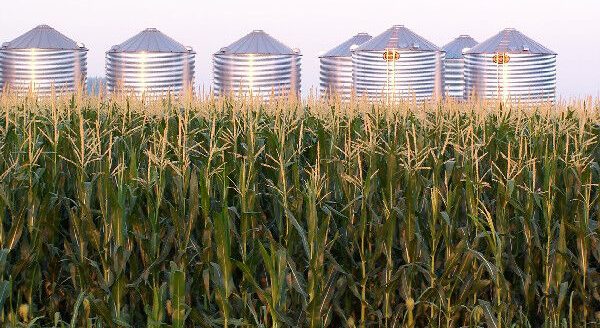Like many Kansas farmers, Jenny Goering is waiting for a better price.
“I’m still holding some from last year,” she said of her corn crop, adding that “by nature, I’m a little bullish.”
Goering and her brother, Matthew, spent Jan. 8 at Kansas State’s Corn Management School in Hesston, learning more about what the crop could face in 2018—from weeds and insects to disease pressure and soil health. But one takeaway on the mind of Goering, as commodity prices hover around break-even levels on her family farm near Moundridge, was the words of K-State Agricultural Economist Dan O’Brien about the 2018 corn market outlook: that despite all the corn in the world, demand remains strong.
While the markets might seem bleak, she sees a little encouragement. “It’s reassuring that I might get my storage out of it,” she said of the crop safely stored in the local elevator.
More carryover but more consumption
The market is sitting on a lot of corn supplies—which is evident from the piles still on the ground at some elevators, O’Brien said to a full crowd at Hesston’s AGCO Corp.
The latest January report showed corn production is estimated at 14.604 billion in 2017-2018—up 26 million bushels, he said.
While that’s an increase from previous estimates, O’Brien tries to give some hope to farmers, telling them grain is moving and to consider the ending stocks, which, at present are projected at 2.5 billion bushels.
“If there is a matrix we watch to guide our perceptions of the market, it is this. How big are the stocks, how big are the stocks relative to use?”
For starters, he said, consumption trends continue to look positive. While there is “domestic corn all over the place—piles in western Kansas—we still have a number of them,” O’Brien said. “Those piles are moving and the basis is showing that. We have a lot of users of corn.”
That includes feedlots, ethanol plants and exports, he said.
“The best thing about low prices is it gives users good incentive to buy grain to use for various livestock, industrial and export uses,” he said, adding, “Overall, there are still large stocks, and I think that we do have strong usage.”
Without the strong usage, corn markets would most likely be 50 cents lower, he said.
Usage could lower the ending stocks, as could a crop problem, including the current dry spell across the entire Great Plains.
Thus, if ending stocks would move below 2.3 or 2.25 billion bushels, then the market has to reassess how bearish it has been. A billion fewer bushels could equal at 75-cent to $1 increase in corn.
“We get to more than a billion bushels short, you get to closer to 1.7, 1.6, 1.5 (billion bushels), then you’ll wonder what we were talking about all winter,” O’Brien said.
“We have a large enough corn crop in 2018 to support usage at the current rate of the marketing year—and that rate is 14.5 billion bushels. If we start coming in below 14.5 or 14, then you start to change the stock-to-use picture and the attitude of the market about how worried it is.”
That’s when you see a rise in prices, he said.
So, do you hold on or do you sell?
“Markets are giving a tepid signal,” said O’Brien. With elevators charging a 4- to 5-bushel-a-month storage fee, the market might “just award enough that farmers break even.”
For those like Goering who are looking down the road, forward contracts for October 2018 in central Kansas are around $3.40 a bushel—which, O’Brien said, is on the higher end. The futures price for that same timeframe is $3.80 a bushel.
“A person will struggle to cover costs” with that forward contract pricing, said O’Brien. “You would have to have tremendous yields.”
A weather event could change things, he added.
“Chances are, if there are any worries at all, those futures will reach a higher side,” he said, adding “That’s the seasonality of how risks enter the markets.”
Expanding Kansas corn markets
Meanwhile, Kansas Corn officials continue to look to expand markets as the state’s own corn crop continues to grow.
According to the National Agricultural Statistics Service, the state’s corn crop is forecast at a record 707 million bushels, up 1 percent from last year’s production.
“You can grow more corn, thank you,” said Greg Krissek, executive director Kansas Corn. “But that means we need to continue to develop markets for your corn, and hop-to markets is livestock and our ethanol industry.”
Part of the effort is to increase ethanol blends at the pump. Kansas Corn is working with the Kansas Department of Agriculture to get additional stations to carry blends like E15 and E85, as well as mid-level blends, he said.
E15 fuel contains 15 percent ethanol and works well for any car 2001 and newer. Higher blends up to E85 are choices for flex-fuel vehicle owners.
Krissek said one Wichita company coming on board will be installing dispensers at several stations between now and Memorial Day.
Also, he said, three new Casey’s General Store locations in northeast Kansas have the higher ethanol blends of E15 and E85.
“If we could get E15 as the typical blend as opposed to E10, that gives us an opportunity for another 2 billion bushels of corn to grind for that market,” he said.
Amy Bickel can be reached at 620-860-9433 or [email protected].



